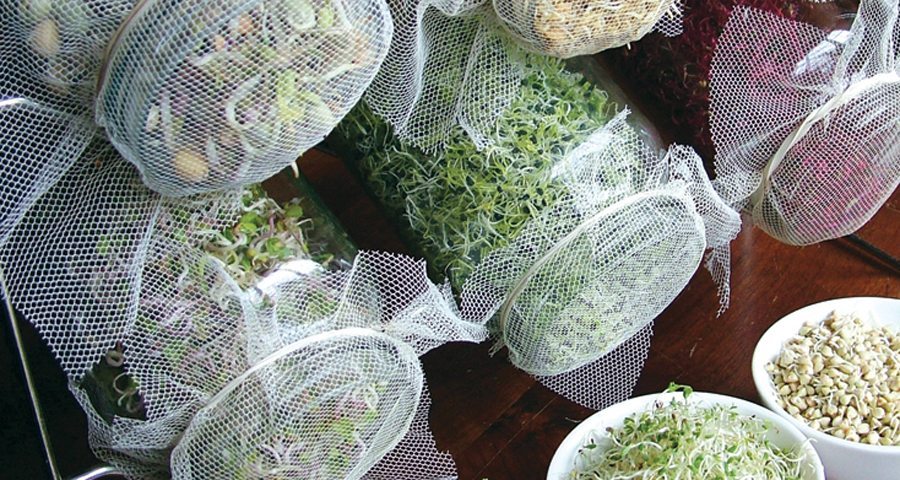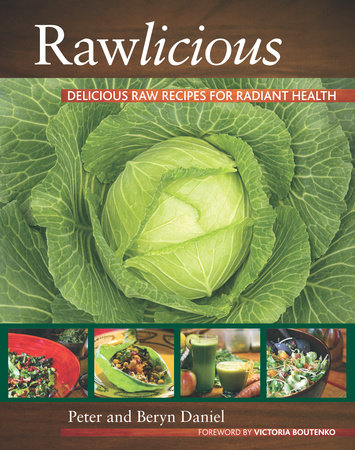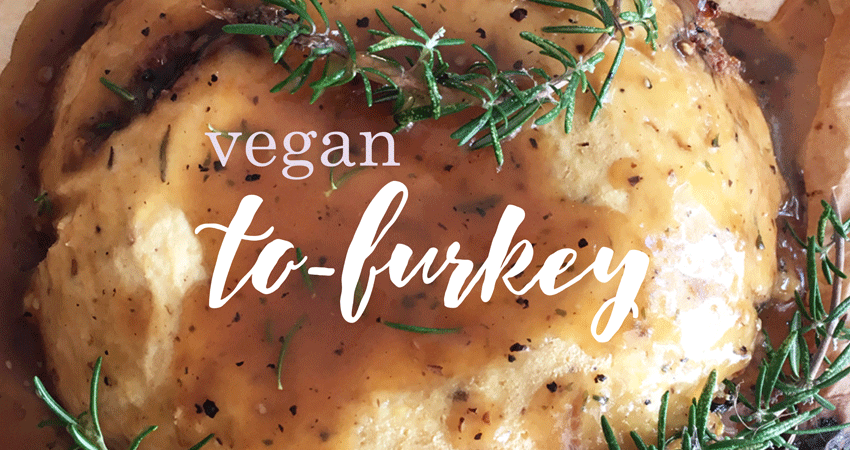
Grow Your Own Food: Sprouts
Categories: Food & Nutrition
In Rawlicious: Delicious Raw Recipes for Radiant Health, Peter and Beryn Daniel, two former bread-and-butter chefs turned raw, show that you don’t have to forsake flavor or flair to enjoy a healthy meal. Praised by Victoria Boutenko as “a precious gift to all food lovers,” Rawlicious is quickly becoming an essential resource for novices and seasoned raw foodists alike.
The section on growing your own sprouts immediately sparked my interest. Did you know that sprouts are enzyme-rich, high in amino acid (protein) content, bursting with minerals and trace minerals, and are packed with chlorophyll? According to Rawlicious, “sprouts are also healing and therapeutic, cleansing and alkalizing, and filled with antiaging antioxidants. Because they are so high in minerals and enzymes, they facilitate digestion, detoxification, and weight loss.” And they taste fantastic too!
Tags: Victoria Boutenko Raw Foods Recipe Vegetarian & Vegan Peter Daniel Beryn DanielThe Glass Jar Method
There are many different sprouting kit options, ranging from stackable plastic rings to glass jars, sprouting bags, and automatic sprouters. My favorite is the glass jar method. Sprouting with this simple system involves soaking your chosen seeds overnight and covering the jar with a mesh screen and rubber band. In the morning drain the soak water and rinse the seeds twice daily, placing them on a rack to drain during the day. Harvest them within three to seven days. Some of the easiest sprouts to grow are alfalfa, fenugreek, radish, broccoli, mung beans, onion, cabbage, mustard seeds, chickpeas, quinoa, lentils, pea sprouts, and wheat seeds. For most sprouts, continue to sprout them until they have developed a long tail or their first leaves have begun to go green. In the case of chickpeas, quinoa, pea sprouts, and lentils, they are ready to eat as soon as their tails begin to unfurl or emerge from the seed.
Sprouting Buckwheat
Buckwheat is a very versatile seed that has many uses in raw dishes. Sprouting buckwheat takes a little more attention. Soak the seeds overnight in a glass jar. In the morning rinse thoroughly. Place the seeds in a large bowl or glass jar and cover with a dish towel. Allow to sprout for one to two days. The sprouts are ready as soon as the little tail has emerged from the seed. Buckwheat releases a gelatinous substance that needs to be rinsed away thoroughly in order to avoid mold.
Soil-grown Microgreens
Another way of growing sprouts is directly in soil trays. These kind of sprouts are called microgreens. My favorites are wheatgrass, barleygrass, or sunflower greens.
How to grow soil-based sprouts:
- Buy trays and organic growing soil from a garden nursery.
- Fill the trays with soil.
- Soak wheat, barley, or sunflower seeds overnight.
- Drain them in the morning and allow them to stand in a bowl for 24–48 hours.
- Small tails will sprout.
- Place the seeds on top of the soil, cover with another thin layer of soil, and lightly water them.
- Place them in an area that gets either the morning or afternoon sun (midday summer sun will burn the young shoots) and water daily.
- Harvest the wheatgrass or barleygrass after seven to ten days and juice it.
- Harvest the sunflower sprouts after seven to ten days and either juice them or eat them in salads.
To provide your soil-grown sprouts with a full complement of minerals and trace minerals, take Himalayan rock salt and make a salt-water solution of one part salt to 200 parts water. Water the sprouts from day four to day seven with this salt-water solution. Alternatively, get sea water (from a clean source, preferably a few miles out to sea) and make the solution from one part sea water to 20 parts fresh water and proceed as before. You will have the healthiest looking, best-tasting, super-nutritious sprouts around.






Where did you find a rack for the mason jars?
Hi Natural Munch! I agree, this rack looks amazing!! Would love to know where it came from! I found another solution, you can use a vertical (or hanging) dish rack that drains into the sink and just put your jars directly on the rack, like this one from Ikea that we use: http://www.ikea.com/us/en/catalog/products/10018194/
nice post…
my sweetie and I have been doing this for a few months now; you would be SO SURPRISED at how many things you can “sprout”; great post!
Great post! I have been wanting to try sprouting for a while…I have a few questions though: what kind of mesh screen do you use? Can I use seeds that would be for planting in the garden? Could I use quinoa that I would just buy in the bulk section at my grocery store? I also can’t seem to find a lot of these things to be sprouted in regular grocery stores–where would you suggest I look? Online? Thanks so much! I look forward to trying this!!
You can try using a cheesecloth
You can find many types of lentils and pulses like moong beans in a bulk barn type of store or an Indian grocery store – a whole lot cheaper.
Old nylon hose (like pantyhose) works well, too.
You want to make sure that the seeds have lots of room in the jar, too, so that when you get sprouts they aren’t crammed together.
Hi Tracey, we use a simple synthetic netting mesh, small enough holes to not let the tiny seeds come out. Often curtain netting will do. Natural fibers tend to rot too quickly. Garden seeds can work, but make sure they are organic and untreated, as garden seeds often have dyes or preservative chemicals coating them. Quinoa is one of the seeds that don’t sprout well, rather just soak them in water overnight to soften, and then add them to a salad. They tend to go moldy easily. I would definitely suggest looking for sprouting seeds online, or at health food stores like wholefoods. Remember quality is key to sprouting success, so ideally get Organic but at least untreated seeds. Once you get started and realize how easy it is to sprout and how delicious they are you won’t look back!
Just wondering how you go about incorporating them in your diet? Do you add them to other ingredients? Are there recipes available? Would like to start ASAP but need an u defers ding on how to make it work. Thanks
Here’s an easy recipe for Sunflower Sprout Salad: http://www.northatlanticbooks.com/2011/06/13/sunflower-sprout-salad-perfect-recipe-for-springtime/
I mean I do need an understanding on how to make it work
Thank you for this post. I recently wrote a post about growing sprouts. It sounds like we do them the same. Thanks, again!
Great idea! I want to add this idea to my site for my readers to learn. I just built a new greenhouse with aquaponics, and am trying to find a way to incorporate sprouts. Thanks!
That sounds amazing. I’d love to see the greenhouse. You should write a blog post about it when you incorporate the sprouts Eric!
If you learn how to do sprouting with aquaponics, I would love to know!
[…] sprouts (Learn how to grow your own sprouts here!) […]
What are the red sprouts please.
Beetroot seed sprouts!
I second natural munch’s question – what rack are you using??
One option is to build your own sprouting jar drainage rack. Otherwise, most dish racks work well.
If I was interested in building my own, do you have any tips to get me started?
Hi Abbie, we have someone who makes them locally using welded shell rods, not quite a DIY thing. The simplest I would think would be to get hold of an old wine rack that can angle the jars forward so they can drain easily. This is where we get our racks from: http://www.kitchengarden.co.za/ There is also good info there on sprouting.
This is a dead link..is there another? I’ve traced a few and they are all non existent. Thank you!
Susan, the link works for me! How strange. Try refreshing your page.
pretty poor instructional- would you like some tips?
David, if you have a good set of tips, we’d love to see them! Post them here in the comments, or send an email to nabcommunities@gmail.com with your list, and if it’s a good one, we’ll happily publish them on the site!
hello i am french but i read anglais………..but don’t écirs much…sorry but i do eat sprout to.
For the superb unique healthy eating experience I can recommend one place I found when I was exploring unusual restaurants in Toronto. It’s Rawlicious restaurant where everything is prepared from raw ingredients. This charming place provided me with absolute sensual taste I haven’t experienced before. I can definitely recommend everyone trying this place! Feels more than well to eat healthy food with delicious taste.
wonderful…..
[…] on: 05/31/2012 Open to: United States Enter this Giveaway at NAB Communities Tweet […]
While seeds are soaking/sprouting, should they be refrigerated or kept at room temperature? If at room temp., should they be kept enclosed (such as in a cabinet/pantry) or left exposed to light (on kitchen counter)?
If you’re growing soil-based sprouts, they need to be placed in a spot gets either morning or afternoon sun (midday summer sun will burn young shoots).
They really don’t need the sunlight. You can just place the jar on your kitchen counter and toss a dish towel over it. They’ll sprout and you won’t have the bitterness that sometimes comes with the greening of the new leaves.
I have read many times not to sprout and eat buckwheat greens, because of toxins that cause photosensitivity.
I googled “buckwheat greens toxins” and I found this helpful response to the question of whether or not eating the greens would be toxic on the Big Raw Blog: http://bigrawblog.blogspot.com/2010/03/vegan-waffle-party-2010-buckwheat.html
It seems like it’s not necessarily toxic in smaller doses, but you’re right that people should definitely consume buckwheat greens with caution! Thanks for sharing your info.
[…] I’m really not much of a sandwich eater, but I like sprouts, so I was thinking of growing my own… maybe for some sprouted […]
[…] http://www.northatlanticbooks.com/2011/02/08/grow-your-own-food-sprouts/ […]
[…] Grow Your Own Sprouts In Jars […]
I bought one of these from Amazon and find it works well. Comes with good intructions. http://www.amazon.com/Sproutamo-Easy-Sprout-Sprouter/dp/B000GHUD86/ref=sr_1_8?ie=UTF8&qid=1396012139&sr=8-8&keywords=sprout+jar
Thanks for sharing, Thomas!
[…] How To Grow Your Own Sprouts In Jars […]
Fenugreek sprouts the fastest and is ready to eat 4-5 days. Delish!
Sonya, what type of dishes do you prepare with fenugreek sprouts?
This happens time and again as tea drinkers, expecting a quality brew are
slighted by a saucer with tea bags mixed with a cup or bowl
of warm tap water. Overall, green tea drinkers seem to enjoy better health.
They may typically use a natural drying process such as sun drying or
else wok and coal drying methods.
There is certainly a lot to find out about this topic.
I like all of the points you’ve made.